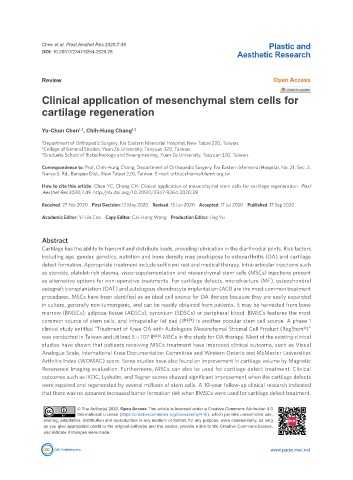Page 563 - Read Online
P. 563
Chen et al. Plast Aesthet Res 2020;7:49 Plastic and
DOI: 10.20517/2347-9264.2020.28 Aesthetic Research
Review Open Access
Clinical application of mesenchymal stem cells for
cartilage regeneration
Yu-Chun Chen , Chih-Hung Chang 1,3
1,2
1 Department of Orthopedic Surgery, Far Eastern Memorial Hospital, New Taipei 220, Taiwan.
2 College of General Studies, Yuan Ze University, Taoyuan 320, Taiwan.
3 Graduate School of Biotechnology and Bioengineering, Yuan Ze University, Taoyuan 320, Taiwan.
Correspondence to: Prof. Chih-Hung Chang, Department of Orthopedic Surgery, Far Eastern Memorial Hospital, No. 21, Sec. 2,
Nanya S. Rd., Banqiao Dist., New Taipei 220, Taiwan. E-mail: orthocch@mail.femh.org.tw
How to cite this article: Chen YC, Chang CH. Clinical application of mesenchymal stem cells for cartilage regeneration. Plast
Aesthet Res 2020;7:49. http://dx.doi.org/10.20517/2347-9264.2020.28
Received: 27 Feb 2020 First Decision: 12 May 2020 Revised: 13 Jun 2020 Accepted: 17 Jul 2020 Published: 17 Sep 2020
Academic Editor: Yi-Lin Cao Copy Editor: Cai-Hong Wang Production Editor: Jing Yu
Abstract
Cartilage has the ability to transmit and distribute loads, providing lubrication in the diarthrodial joints. Risk factors
including age, gender, genetics, nutrition and bone density may predispose to osteoarthritis (OA) and cartilage
defect formation. Appropriate treatment include sufficient rest and medical therapy. Intra-articular injections such
as steroids, platelet-rich plasma, visco-supplementation and mesenchymal stem cells (MSCs) injections present
as alternative options for non-operative treatments. For cartilage defects, microfracture (MF), osteochondral
autograft transplantation (OAT) and autologous chondrocyte implantation (ACI) are the most common treatment
procedures. MSCs have been identified as an ideal cell source for OA therapy because they are easily expanded
in culture, generally non-tumorigenic, and can be readily obtained from patients. It may be harvested from bone
marrow (BMSCs), adipose tissue (ADSCs), synovium (SDSCs) or peripheral blood. BMSCs features the most
common source of stem cells, and infrapatellar fat pad (IPFP) is another popular stem cell source. A phase 1
clinical study entitled “Treatment of Knee OA with Autologous Mesenchymal Stromal Cell Product (RegStem®)”
was conducted in Taiwan and utilized 5 × 107 IPFP-MSCs in the study for OA therapy. Most of the existing clinical
studies have shown that patients receiving MSCs treatment have improved clinical outcome, such as Visual
Analogue Scale, International Knee Documentation Committee and Western Ontario and McMaster Universities
Arthritis Index (WOMAC) score. Some studies have also found an improvement in cartilage volume by Magnetic
Resonance Imaging evaluation. Furthermore, MSCs can also be used for cartilage defect treatment. Clinical
outcomes such as IKDC, Lysholm, and Tegner scores showed significant improvement when the cartilage defects
were repaired and regenerated by several millions of stem cells. A 10-year follow-up clinical research indicated
that there was no apparent increased tumor formation risk when BMSCs were used for cartilage defect treatment.
© The Author(s) 2020. Open Access This article is licensed under a Creative Commons Attribution 4.0
International License (https://creativecommons.org/licenses/by/4.0/), which permits unrestricted use,
sharing, adaptation, distribution and reproduction in any medium or format, for any purpose, even commercially, as long
as you give appropriate credit to the original author(s) and the source, provide a link to the Creative Commons license,
and indicate if changes were made.
www.parjournal.net

